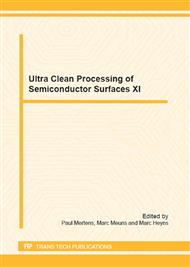p.239
p.243
p.247
p.252
p.261
p.265
p.269
p.274
p.277
Diffusion Behavior of Transition Metals Penetrating Silicon Substrate through Silicon Dioxides by Dopant Ion Implantation
Abstract:
Metallic contamination on silicon surfaces has a detrimental impact on ULSI device performance and yield. Surface metal impurities degrade gate oxide integrity while metal impurities dissolved in silicon cause recombination centers and result in junction leakage. Surface metal impurities penetrate silicon by the colliding with dopant during ion implantation and are also diffused in silicon by subsequent annealing [. The diffusion behavior of metal impurities in silicon is well-known [. While metal impurities often penetrate silicon through the silicon oxide in ULSI processing, little work has been reported on the diffusion behavior of metal impurities penetrating silicon oxide. We demonstrated the diffusion behavior of metal impurities penetrating silicon substrates with different thickness of silicon oxide by the collision with dopant during ion implantation.
Info:
Periodical:
Pages:
261-264
Citation:
Online since:
December 2012
Authors:
Price:
Сopyright:
© 2013 Trans Tech Publications Ltd. All Rights Reserved
Share:
Citation:


